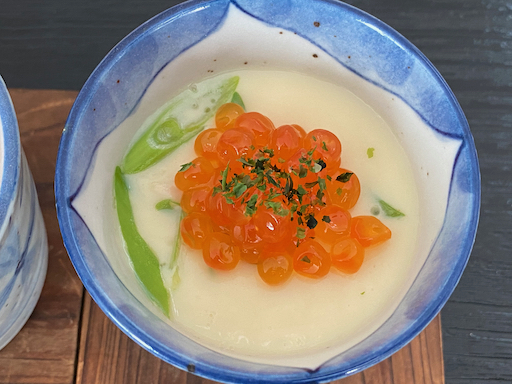This is on the theme of multiple small appetizers served in a multi- divided plate. We got delivery of some Japanese vegetables which included eggplant, lily bulb and wood ear mushroom among other things. I served five appetizers. Two of them are new and are the ones I am presenting here.
Lilly bulb with ikura. This is a very simple but good dish. I separated the lily bulb into individual pieces and briefly boiled them. After they cooled I refrigerated them. I served them as shown below. I just topped each lily bulb cup shaped piece with marinated ikura salmon roe. Due to its simplicity I did not include a formal ingredients and directions section for this dish below. The slightly sweet and mildly crunchy texture of the lily bulb went well with the taste of the marinated ikura.
The picture below shows the eggplant and wood ear mushroom dish. I dressed it in mustard sauce which was slightly spicy, vinegary and sweet. The sauce gave an unexpected but nice bright note to the dish while the texture contrast between the thinly sliced eggplant and crunchy wood ear mushroom was a nice combination.
As mentioned, these were two among the 5 appetizers I served. I made two 5 dish appetizer plates one evening as shown below. (One for myself and one for my wife). The picture shows the two dishes discussed above along with the other three that made up the 5 dish plate. From left to right are; store bought fish cake warmed in the toaster oven, the eggplant and wood ear dressed in mustard sauce, lily bulb with ikura, eggplant “agebitashi” with mushrooms, and hijiki and fried tofu stir fry.
The eggplant and wood ear dish in mustard sauce (recipe came from
eRecipe - in Japanese)
Ingredients:
One Japanese (Asian) eggplant (long slender kind)
Wood ear (I used fresh which was blanched and cooled) if using dried, hydrate and removed the hard parts and blanch it, amount arbitrary
For dressing: (amount all to taste)
Japanese (hot) prepared mustard, amount arbitrary, from tube
Sweet vinegar (this was home-made) or sushi vinegar
Soy sauce
Directions:
Cut the eggplant with stem end removed, in half length-wise and then cut thinly across on the bias
Soak the pieces in cold water for 5-10 minutes, squeeze out water and add salt and knead. Let it stand until some moisture comes out and the slice of the eggplant has wilted
Wash in water and squeeze out the excess water
Cut wood ear into bite sized pieces. If attachment ends are hard, remove them.
In a small bowl, add the eggplants, wood ear and the dressing and mix well




.jpeg)
.jpeg)












































